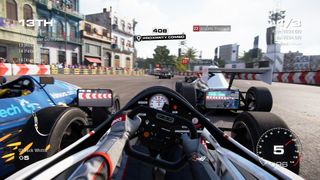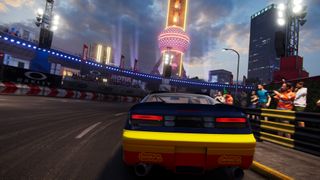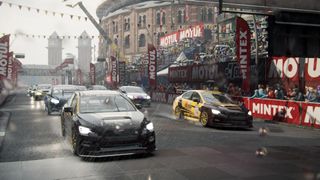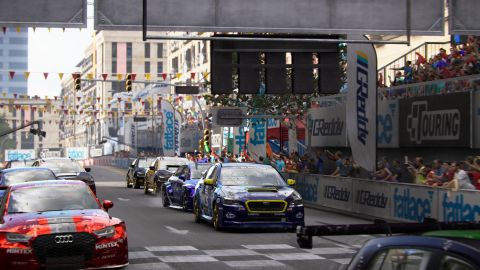Our Verdict
Invigorating arcade racing let down by lightweight multiplayer and campaign modes.
PC Gamer's got your back
What is it? A “back to basics” arcade racer that’s a little too basic for its own good.
Expect to pay $60/£45
Developer: Codemasters
Publisher: Codemasters
Reviewed on: AMD Ryzen 5 3600, Nvidia GTX 2080 Super, 32 GB RAM
Multiplayer: Online, quick or private matches
Link: Official site
After the precise simulation of F1 2019 and the outright terror of the Dirt Rally games, GRID sees Codemasters promise a return to the arcade joys of its beloved 2008 racer. Here, slightly mis-timing a turn isn’t going to ruin your race, and taking the lead from the back of the pack is not just viable within three laps but encouraged. GRID is about enjoying the fantasy of being a racing driver rather than recreating the reality of it.
It’s a promise partially delivered. On the track, GRID is frequently thrilling, less about pedal to the metal and more metal to the other metal, as you shunt and shoulder your way through tightly packed crowds of aggressive and occasionally unhinged AI drivers. Yet off the track, GRID is lacking in features and, in some areas, conviction, with several half-baked ideas that merited deeper exploration.
Initially, you might wonder what there is to complain about. After introducing you to its racing with a montage of three short events, GRID flings you straight into its career mode, presenting you with a literal wall of races. There are four main categories, including touring cars, stock cars, and a “Fernando Alonso” branded supercar category, each of which has fourteen events and somewhere between forty and fifty races. Add to that double the number of “Invitational” events, which let you race anything from Mini Coopers to Ferraris, and you’ve got around 30 hours of racing ahead of you.

The diversity appears impressive at first. You’re allowed to hop between the different categories at will, and GRID responds with a seemingly wide range of locations and race conditions. The early Touring Car events evoke pleasant memories of the TOCA games from the late nineties, as you cruise around Silverstone and Brands Hatch under quintessentially British slate grey skies. From here, you can jump into a grunting muscle car and thrum along the graceful arcs of the Crescent Valley speedway, or head for the opulent GT category and slam a Porsche 911 along the harbourside of Havana.
Two locations stand out from the rest. The first is Barcelona, the streets of which have been recreated in painstaking detail, letting you race along the waterfront past the Columbus Monument, or through the cramped streets of its medieval centre, zipping past the bullring and the glittering fountains of the Palau Nacional. The main attraction, however, is Shanghai. Foreboding by day, at night Shanghai’s skyline explodes into a forest of sparkling neon. Wrestling through the pack as the Oriental Pearl Tower glows in the background makes GRID feel more like you’re playing Wipeout than a contemporary racer.
Although GRID is willing to indulge flights of fancy, a serious effort has gone into designing the feel of the cars. Each one is distinct in its handling and momentum. When barrelling through a corner, there’s a world of difference between the sturdy grace of a Vantage, and the barely-controllable grunt of a Ford Mustang. My personal favourite is the now-mythical BMW M1 Turbo. Driving one of these rainbow-banded beasts is like holding on to a lightning-bolt. Racing sixteen such TC1-class cars through the streets of Barcelona had me leaning away from my screen, certain I was going to turn the car into a giant metal concertina at any moment.

Barebones
For the first five-to-ten hours, GRID is a delight. But I found myself wondering what else GRID had to offer, and it’s at this point where it stalled. That initial burst of locations isn’t the start of some grand tour, it’s all the locations thrown at you within a handful of events, which are then recycled for the following 20 hours. There are different track layouts, of course, but racing Brands Hatch backwards doesn’t lessen the disappointment of returning to Brands Hatch for the fifteenth time when you’re not even halfway through the career.
Bump into a specific car too hard or too often, and they’ll become your “Nemesis”, hulking out and attempting to run you off the road.
The career is generally barebones, little more than an event selection menu. There’s no attempt to fill in the gaps, contextualise your experience with a story or some other framework, or provide a sense of progression beyond the standard rewards, namely cash, cars and more events. Outside the career, play options are limited to single races and multiplayer, neither of which offer an experience much different from what you’ll see in the campaign.
It’s unfortunate, because GRID boasts a couple of potentially interesting ideas. The most notable of these are the new AI driver behaviours. Bump into a specific car too hard or too often, and they’ll become your “Nemesis”, hulking out and attempting to run you off the road. Alongside this you have a teammate who you can set orders for, asking them to push up the field or drive defensively, holding the pack back so you can either catch up or speed away.
This system can lead to some interesting situations. For example, I once made my teammate my nemesis, which resulted in him chasing me furiously right across the finish line. In addition, during an especially crowded race in San Francisco, I ended up pissing off about four drivers, and had to carefully avoid them through the rest of the race like some kind of vehicular slasher film. Unfortunately, vendettas only last for the duration of the race, and the lack of any personality in either individual drivers or the wider career means this isn't the Shadow of Mordor of racing games—a lot of potential is left dangling.

I can’t help but feel like a premium-priced game like this should be doing a bit more, especially if you compare it to something like Forza Horizon 4.
There are other curious issues, too. For example, you can hire new teammates to drive with, but this is never pointed out to you during the career. Instead the option is hidden away on your profile page. Finding a multiplayer game is limited to private lobbies or public matchmaking, with no public lobbies or option to browse for servers. The keyboard control layout is downright bizarre, with button allocations scattered all over the place (for example, gear-change up is assigned to Q, while gear-change down is Left Alt) It’s if the developer crammed the keys up their nose and sneezed them across the board. I know playing a racing game with your keyboard is like playing a piano while holding a pair of pan lids, but there’s no need to make it harder than it already is.
This is still an entertaining racer, one that looks lovely and runs smoothly. But I can’t help but feel like a premium-priced game like this should be doing a bit more, especially if you compare it to something like Forza Horizon 4, a similarly arcadey experience, but with considerably more to offer. Had GRID explored some of its ideas in greater depth, that might have given it the extra boost for a podium finish. Yet talented on the track as it maybe, it nonetheless falls just short of that.
Invigorating arcade racing let down by lightweight multiplayer and campaign modes.

Riot has been slowly chipping away at build creativity in League of Legends, all in the name of balance, but there are better solutions

Deus Ex director Warren Spector thinks that 'if someone made Deus Ex today it might be perceived as a documentary,' so if he made a new one it would be pretty different

Today's Wordle answer for Sunday, November 10
